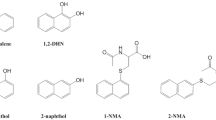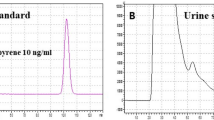Abstract
Purpose
To study the excretion kinetics of urinary toluene, TOL-U, and o-cresol, o-C, following occupational exposure to toluene in order to define the best time for sample collection, to apply a non-invasive approach based on self-collected urine sampling.
Methods
Five rotogravure printing workers exposed to uncontrolled levels of toluene collected spot urine samples over three consecutive working days and the following day of rest. In each sample TOL-U and o-C were measured and kinetics of excretion evaluated.
Results
Toluene exposure ranged from 48.3 to 75.3 mg/m3; TOL-U and o-C ranged from 1.4 to 34.6 μg/L and from 0.013 to 1.012 mg/L. A time course trend was obtained: TOL-U and o-C increased during the shift and peaked at the end of exposure and up to 2 h later, respectively; afterwards they rapidly decreased following apparent first order kinetics. Considering TOL-U, the elimination half-life for the first fast phase was 79 (±35 standard error) min, and for the second slow phase was 1,320 (±1,162) min. For o-C the elimination half-life for the first fast phase was 231 (±48) min. Considering a toluene uptake of 86%, TOL-U and o-C excreted in urine were about 0.0067 and 0.18% of the up taken.
Conclusion
Our results support the use of end shift TOL-U as a short term biomarker of occupational exposure to toluene and show the feasibility of self-collected urine sampling to investigate the elimination kinetics of industrial toxics in humans.




Similar content being viewed by others
References
American Conference of Governmental Industrial Hygienists (ACGIH) (2007) TLVs and BEIs based on the documentation of the threshold limit values for chemical substances and physical agents and biological indices. Cincinnati, USA
Brugnone F, Perbellini L, Gaffuri E, Apostoli P (1980) Biomonitoring of industrial solvent exposures in workers’ alveolar air. Int Arch Occup Environ Health 47:245–261. doi:10.1007/BF00381682
Deutsch Forschungsgemeinschaft (DFG) (2007) List of MAK and BAT values 2007. Report No 40, Weinheim: DFG, WILEY-VCH
Ducos P, Berode M, Francin JM, Arnoux C, Lefèvre C (2008) Biological monitoring of exposure to solvents using the chemical itself in urine: application to toluene. Int Arch Occup Environ Health 81:273–284. doi:10.1007/s00420-007-0210-3
Fustinoni S, Giampiccolo R, Pulvirenti S, Buratti M, Colombi A (1999) Headspace solid-phase microextraction for the determination of benzene, toluene, ethylbenzene and xylenes in urine. J Chromatogr B Analyt Technol Biomed Life Sci 723:105–115. doi:10.1016/S0378-4347(98)00515-5
Fustinoni S, Buratti M, Giampiccolo R, Brambilla G, Foà V, Colombi A (2000) Comparison between blood and urinary toluene as biomarkers of exposure to toluene. Int Arch Occup Environ Health 73:389–396. doi:10.1007/s004200000156
Fustinoni S, Consonni D, Campo L, Buratti M, Colombi A, Pesatori AC, Bonzini M, Bertazzi PA, Foà V, Garte S, Farmer PB, Levy LS, Pala M, Valerio F, Fontana V, Desideri A, Merlo DF (2005a) Monitoring low benzene exposure: comparative evaluation of urinary biomarkers, influence of cigarette smoking and genetic polymorphisms. Cancer Epidemiol Biomarkers Prev 14:2237–2244. doi:10.1158/1055-9965.EPI-04-0798
Fustinoni S, Mercadante R, Campo L, Scibetta L, Valla C, Foà V (2005b) Determination of urinary ortho- and meta-cresol in humans by headspace SPME gas chromatography/mass spectrometry. J Chromatogr B Analyt Technol Biomed Life Sci 817:309–317. doi:10.1016/j.jchromb.2004.12.029
Fustinoni S, Mercadante R, Campo L, Scibetta L, Valla C, Foà V (2007) Comparisons between TOL-U and urinary ortho- and meta-cresol in humans by headspace SPME gas chromatography/mass spectrometry. J Occup Environ Hyg 817:309–317
Garrett ER (1994) The Bateman function revised: a critical reevaluation of the quantitative expressions to characterize concentrations in one compartment body model as a function of time with first-order invasion and first-order elimination. J Pharmacokinet Biopharm 22:103–128. doi:10.1007/BF02353538
Ghittori S, Alessio A, Maestri L, Negri S, Sgroi M, Zandra P (2002) Schede informative per il monitoraggio biologico. G Ital Med Lav Ergon 24:133–137 [document in Italian]. http://www.gimle.fsm.it. Accessed 15 June 2008
Hazardous Substance Data Bank. Toluene. http://toxnet.nlm.nih.gov. Accessed 15 June 2008
Ikeda M (1999) Solvents in urine as exposure markers. Toxicol Lett 108:99–106. doi:10.1016/S0378-4274(99)00078-8
Imbriani M, Ghittori S (2005) Gases and organic solvents in urine as biomarkers of occupational exposure: a review. Int Arch Occup Environ Health 78:1–19. doi:10.1007/s00420-004-0544-z
Imbriani M, Ghittori S, Pezzagno G, Capodaglio E (1986) Toluene and styrene in urine as biological exposure indices. Appl Ind Hyg 1:172–176
Jakubowski M, Trzcinka-Ochocka M (2005) Biological monitoring of exposure: trends and key developments. J Occup Health 47:22–48. doi:10.1539/joh.47.22
Janasik B, Jakubowski M, Jałowiecki P (2008) Excretion of unchanged volatile organic compounds (toluene, ethylbenzene, xylene and mesitylene) in urine as result of experimental human volunteer exposure. Int Arch Occup Environ Health 81:443–449. doi:10.1007/s00420-007-0233-9
Japan Society for Occupational Health (2000) Recommendation of occupational exposure limits. J Occup Health 42:213–228. doi:10.1539/joh.42.213
Kawai T, Mizunuma K, Okada Y, Horiguchi S, Ikeda M (1996) Toluene itself as the best urinary marker of toluene exposure. Int Arch Occup Environ Health 68:289–297. doi:10.1007/BF00409413
Kawai T, Ukai H, Maejima Y, Fukui Y, Ohashi F, Okamoto S, Takada S, Sakurai H, Ikeda M (2008) Evaluation of biomarkers of occupational exposure to toluene at low levels. Int Arch Occup Environ Health 81:253–262. doi:10.1007/s00420-007-0203-2
Lin YS, Egeghy PP, Rappaport SM (2007) Relationships between levels of volatile organic compounds in air and blood from the general population. J Expo Sci Environ Epidemiol 18(4):421–429. doi:10.1038/sj.jes.7500635
Löf A, Hjelm EW, Colmsjö A, Lundmark BO, Norström A, Sato A (1993) Toxicokinetics of toluene and urinary excretion of hippuric acid after human exposure to 2H8-toluene. Br J Ind Med 50:55–59
Nise G (1992) Urinary excretion of o-cresol and hippuric acid after toluene exposure in rotogravure printing. Int Arch Occup Environ Health 63:377–381. doi:10.1007/BF00386931
Pezzagno G, Imbriani M, Ghittori S, Capodaglio E (1985) Significance of the urinary excretion of toluene as indices of exposure. Med Lav 76:44–60 (article in Italian)
Pierce CH, Chen Y, Hurtle WR, Morgan MS (2004) Exponential modeling, washout curve reconstruction, and estimation of half-life of toluene and its metabolites. J Toxicol Environ Health A 67:1131–1158
Pierce CH, Dills RL, Kalman DA, Morgan MS, Vicini P, Kalaman DA (1998) Biological monitoring of controlled toluene exposure. Int Arch Occup Environ Health 71:433–444. doi:10.1007/s004200050303
Scientific Committee on Occupational Exposure Limits (SCOEL) (2001) Recommendation from Scientific Committee on Occupational Exposure Limits for Toluene SCOEL/SUM/18H, European Commission
Takeuchi A, Kawai T, Zhang Z-W, Miyama Y, Sakamoto K, Higashikawa K, Ikeda M (2002) Toluene, xylenes and xylene isomers in urine as biological indicators of low-level exposure to each solvent; a comparative study. Int Arch Occup Environ Health 75:387–393. doi:10.1007/s00420-002-0331-7
Ukai H, Kawai T, Inoue O, Maejima Y, Fukui Y, Ohashi F, Okamoto S, Takada S, Sakurai H, Ikeda M (2007) Comparative evaluation of biomarkers of occupational exposure to toluene. Int Arch Occup Environ Health 81:81–93. doi:10.1007/s00420-007-0193-0
Acknowledgments
We are indebted to the health personnel of the rotogravure printing industry and, in particular, to P. Bergamo for helping in managing the field survey and to the subjects who volunteered for the study.
Author information
Authors and Affiliations
Corresponding author
Rights and permissions
About this article
Cite this article
Fustinoni, S., Mercadante, R. & Campo, L. Self-collected urine sampling to study the kinetics of urinary toluene (and o-cresol) and define the best sampling time for biomonitoring. Int Arch Occup Environ Health 82, 703–713 (2009). https://doi.org/10.1007/s00420-008-0393-2
Received:
Accepted:
Published:
Issue Date:
DOI: https://doi.org/10.1007/s00420-008-0393-2




